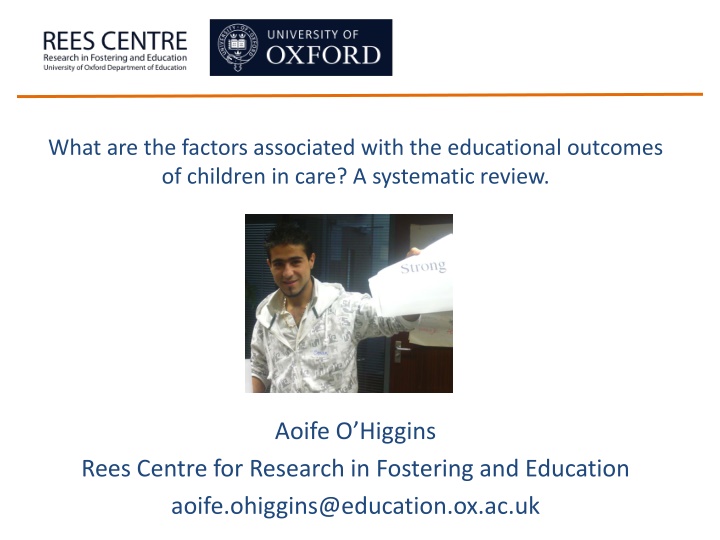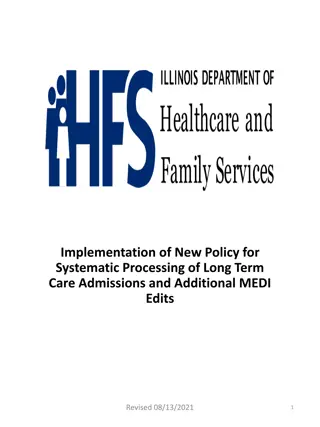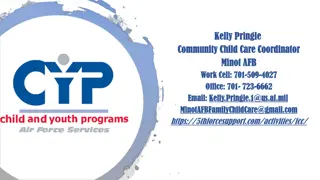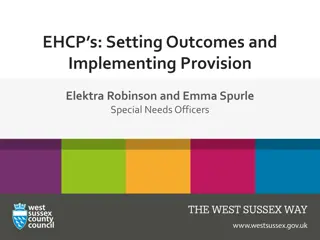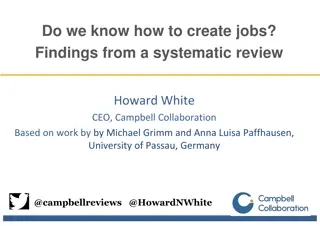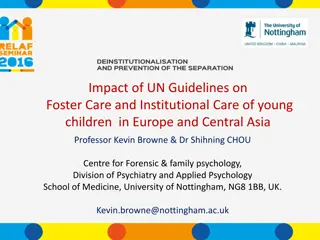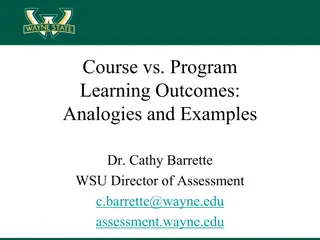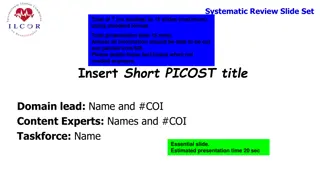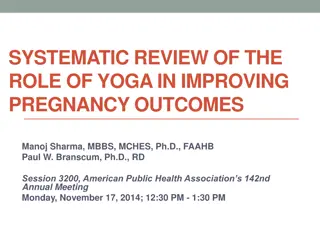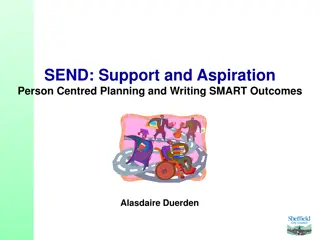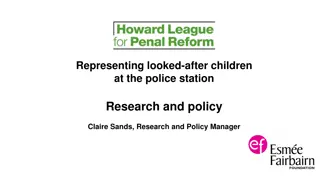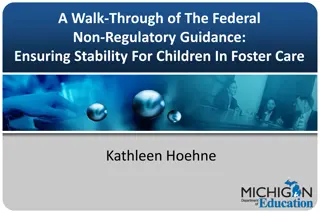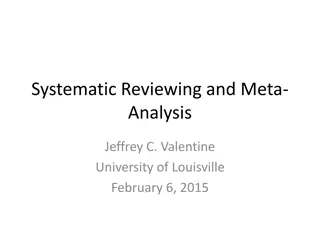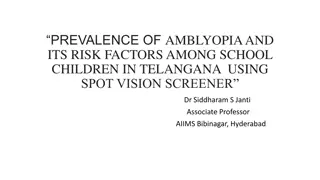Factors Affecting Educational Outcomes of Children in Care: A Systematic Review
This systematic review explores the factors impacting the educational outcomes of children in care, addressing low attainment and intervention efficacy. Methodological challenges, risk factors, and key elements in the evaluation process are discussed, aiming to fill knowledge gaps and provide insights for future research.
Download Presentation

Please find below an Image/Link to download the presentation.
The content on the website is provided AS IS for your information and personal use only. It may not be sold, licensed, or shared on other websites without obtaining consent from the author.If you encounter any issues during the download, it is possible that the publisher has removed the file from their server.
You are allowed to download the files provided on this website for personal or commercial use, subject to the condition that they are used lawfully. All files are the property of their respective owners.
The content on the website is provided AS IS for your information and personal use only. It may not be sold, licensed, or shared on other websites without obtaining consent from the author.
E N D
Presentation Transcript
What are the factors associated with the educational outcomes of children in care? A systematic review. Aoife O Higgins Rees Centre for Research in Fostering and Education aoife.ohiggins@education.ox.ac.uk
What are the factors associated with the educational outcomes of children in care? A systematic review. Rationale for the research Systematic reviews Methodological challenges Findings from the review Are we any wiser?
Rationale for the research Low educational attainment of children in care (Trout et al., 2008; Scherr, 2007) Interventions for the education of children in care limited success (Liabo et al. 2012; Forsman & Vinnerljung, 2012) Theory of change? Evidence base?
Rationale for the research (cont.) Risk factors! Key elements of the development and evaluation process (Craig et al., 2008: Guidance on Development of Complex Interventions)
Systematic reviews Knowledge gap: What are the factors associated with educational outcomes of children in care? A systematic review aims to comprehensively locate and synthesize research that bears on a particular research question, using organised, transparent and replicable procedures at each step in the process (Littell et al., 2008) Systematic reviews of risk factors are lacking, complex but necessary (Murray et al., 2009)
Systematic review: decisions to be made Population: excluded children in residential care because needs are likely to be different Comparison groups: none necessary Outcomes: only standardized outcomes Methodologies: only quantitative Dates? Languages? Sources of data?
Systematic reviews: methodological challenges Defining risk factors (Kraemer et al., 2005) Search string: risk Risk concept absent from most studies Protective / promotive factors are complex Being in care associated with low attainment > Offshoot review: is being in care associated with low educational attainment? OR Is being in care an effective intervention for educational outcomes? Critical appraisal & synthesis made difficult by heterogeneity (e.g. length of time in care).
Systematic reviews: data sources Databases ERIC British Education Index Australian Education Index International Bibliography of Social Sciences Scopus Medline PsycInfo Social Services Abstracts Sociological Abstracts Database of Education Research (EPPI Centre) Campbell and Cochrane Libraries Social Policy and Practice (part of SCIE) Google and Google Scholar Websites NFER C4EO CERUK Plus (Current education & children s services research UK) SCIE The Fostering Network BAAF NCB NSPCC Joanna Briggs Institute What Works Clearinghouse Department for Education Chapin Hall Office of Planning, Research and Evaluation in Administration for Children and Families (USA). CYSR hand searched Experts contacted
Systematic reviews: findings 7135 studies identified & screened 331 full text obtained & analysed for inclusion 294 excluded 37 included All in English, all post 1990. How many have I missed?
Systematic reviews: findings (cont.) Individual factors: Age Gender Ethnicity Special Educational Needs Behavioural problems Mental Health IQ Language (Bronfennbrenner, 1979)
Systematic reviews: findings (cont.) Family factors: Birth families Carer characteristics Carer level of education Carer aspirations / expectations Carer involvement (school / home) Home characteristics
Systematic reviews: findings (cont.) Care history factors: Age at entry Reason for entry Length of time in care Number of placements / stability Placement type Social work
Systematic reviews: findings (cont.) School factors: School transfers Aspirations for further/higher education Attendance Grade retention Receiving extra help (intervention) Teachers expectations No studies looked at structural factors
Example: length of time in care 45 40 35 Percentage achieving 30 25 5+ GCSEs at grades A*-C 20 15 5+ GCSEs at grades A*-c including English and mathematics 10 5 0 12 to 18 months 18 2 to 3 years 3 to 4 years 4 to 5 years 5 to 6 years 6 years or more months to 2 years (Department for Education for England, 2013) Length of time in care
Example: length of time in care Educational outcomes of children in care in study samples did not vary by the length of time children spent in care (Aldgate et al., 1992; AIHW, 2007, 2011; Burley and Halpern, 2001; Berger et al., 2009; Evans, 2004; Geenen and Powers, 2006; Sawyer and Dubowitz, 1994; Townsend, 2012) Conger and Rebeck (2001) determined that children performed better on reading and maths scores if they stayed in care for the minimum duration of the semester after they entered. Leaving care in the middle of the semester was also associated with poorer attendance. Is this instability rather than length of time in care? Zima et al. (2000) found that children who had been living in foster care for a greater number of years were significantly more likely to have been excluded from school. De Lemos (1997) also found that the longer children spent in care, the lower their academic outcomes.
Example: length of time in care Why? Different context? Who are the participants? Methodology used? Can we trust the findings anyway?
Conclusion: Are we any wiser? Fixed correlates (correlate with the outcome, can t be changed): age, gender, ethnicity, special educational needs, mental health, behavioural problems. These may moderate the outcome, they indicate whether interventions should be targeted at specific populations (Only one included study did moderation analysis)
Conclusion: Are we any wiser? Risk correlates (correlate with the outcome): length of time in care, number of placements, placement type, school transfers, etc. Risk factors (correlate + occur before the outcome): Age at entry (is it a proxy?), birth risks, reason for entering care (proxy?).
Conclusion: Are we any wiser? Protective / promotive factors: Carer involvement Carer aspirations Positive feelings about school Are these points for intervention?
References Other than included studies Bronfenbrenner, U. (1979). The ecology of human development: Experiments by nature and design. Harvard University Press (p. 330). Harvard University Press. Retrieved from http://www.amazon.com/dp/0674224574 Craig, P., Dieppe, P., Macintyre, S., Michie, S., Nazareth, I., & Petticrew, M. (2008). Developing and evaluating complex interventions: the new Medical Research Council guidance. British Medical Journal, 337, 979 983. Retrieved from http://dx.doi.org/10.1136/bmj.a1655 DfE. (2013). First Statistical Release: Children looked after in England (including adoption and care leavers) year ending 31 March 2013 (p. 19). London. Retrieved from https://www.gov.uk/government/uploads/system/uploads/attachment_data/file/244872/SFR36_2013.pdf Forsman, H., & Vinnerljung, B. (2012). Interventions aiming to improve school achievements of children in out-of-home care: A scoping review. Children and Youth Services Review, 34(6), 1084 1091. doi:10.1016/j.childyouth.2012.01.037 Fraser, M. W., Richman, J. M., Galinsky, M. J., & Day, S. H. (2009). Intervention Research: Developing Social Programs. New York City, NY: Oxford University Press. Kraemer, H. C., Kraemer Lowe, K., & Kupfer, D. J. (2005). How to understand what research tells us about risk to your health. New York City, NY: Oxford University Press. Liabo, K., Gray, K., & Mulcahy, D. (2012). A systematic review of interventions to support looked-after children in school. Child & Family Social Work, 1 13. doi:10.1111/j.1365-2206.2012.00850.x Littell, J. H., Corcoran, J., & Pillai, V. (2008). Systematic Reviews and Meta-Analysis. New York City, NY: Oxford University Press. Murray, J., Farrington, D. P., & Eisner, M. P. (2009). Drawing conclusions about causes from systematic reviews of risk factors: The Cambridge Quality Checklists. Journal of Experimental Criminology, 5(1), 1 23. doi:10.1007/s11292-008-9066-0 Scherr, T. G. (2007). Educational Experiences of Children in Foster Care: Meta-Analyses of Special Education, Retention and Discipline Rates. School Psychology International, 28(4), 419 436. doi:10.1177/0143034307084133 Trout, A. L., Hagaman, J., Casey, K., Reid, R., & Epstein, M. H. (2008). The academic status of children and youth in out-of- home care: A review of the literature. Children and Youth Services Review, 30(9), 979 994. doi:10.1016/j.childyouth.2007.11.019
